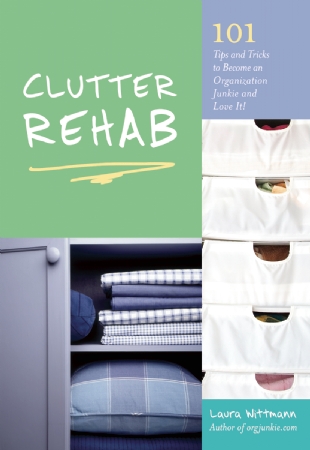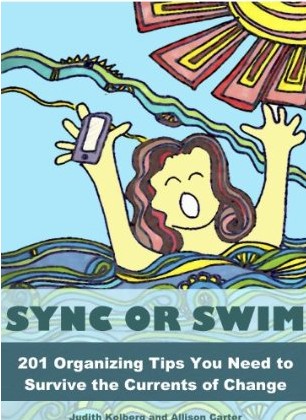Paper Doll Gets Tip-sy, Reviews Tips Books “Clutter Rehab” and “Sync or Swim”
If you’ve ever spent any time in the Organizing and Time Management sections of a bookstore, you know that there are a few different sub-genres of these books.
For example, there are the glossy coffee table books and otherwise hefty tomes that are mainly photo arrays, designed to appeal to the aesthetic fantasies of readers. The layouts are usually accompanied by a sentence or two of explanation, and the reader is expected to know where to buy the tools or materials to accomplish the vision, and how to bring that vision to fruition. Like high gloss fashion magazines and dcor catalogs, these books reflect an illusion more suited to a parody blog than a serious review. I’m fairly sure you’ll never see Paper Doll review a book of that sort.
Conversely, there are books at the opposite end of the spectrum that delve into the psychology behind organizing and time management issues. For example, in the past I’ve reviewed Everything I Know About Perfectionism I Learned From My Breasts by Debbie Jordan Kravitz.
In the middle, there are the best-sellers from big-name professional organizers like Julie Morgenstern and Peter Walsh, and the authors whom I’ve reviewed previously, who combine philosophy and practicality around a central organizing theme or rubric. To benefit fully from these books, the reader must make a greater investment of time.

And then there are the tips books. This genre isn’t for those who are chronically disorganized or suffering from hoarding, nor is it for those who need a primer on the basic elements of getting organized because they were never given a foundation in creating streamlined systems.
Rather, tips books are perfect for the those seeking a few ideas to help them solve small, specific problems and to enable them to visualize what the solution might look like. Taken as a whole, tips books usually don’t yield absolute revelations, epiphanies or grand new ways of looking at life. I truly doubt anyone who has spent thirty or forty years going by her gut, tossing things hither and yon, is going to read a tips book and say, “Aha! Henceforth, I shall group like with like, purge items that fail to support my goals and label my color-coded files hierarchically.” (Actually, I’m fairly sure I’m one of the few people who still uses the word “henceforth” outside of the legal realm.)
Thus, rather than providing revelation, tips books mostly succeed by reminding readers of what they already know (organizing basics), clarifying the essence of a type of problem, and offering a reasonable, cost-effective solution. A clear, colorful photo or a link to a helpful product, service or website is a bonus.
Today, I’d like to share two of the recent tips books that have caught my eye.
Clutter Rehab: 101 Tips and Tricks to Become an Organization Junkie and Love It! by Laura Wittmann

Wittmann may be better known to you as @orgjunkie on Twitter and the author of the Organizing Junkie blog. A work-at-home mom in Alberta, Canada, Wittmann is not a professional organizer working with clients, but over the years, she has consistently impressed me with the organizing information empire of her website and blog, where she teaches readers how to organize their space, systems (including menu planning) and time.
Most of Wittmann’s Clutter Rehab tips are practical and instructional. She’s created a series of self-enclosed, miniature projects for making strides towards achieving organization in one small area of life at a time. Wittmann’s Clutter Rehab is no Martha Stewartesque Create-A-Household-Delight-in-Forty-Seven-Simple-Steps…of which I say, it’s a good thing. (Pun entirely intended.) Rather, Wittmann’s tips are cheery, straightforward, and easy to put into action with 15 or 30 minutes of effort.
Each kernel of wisdom includes advice describing a problem and how to quickly and easily solve it with low-budget solutions using materials likely to already be on hand or which can be inexpensively acquired. For example, some tips provide guidance on how to quickly create simple systems like using a dollar store carabiner clip to keep keys accessible and organized (#6) or how to create a jewelry organizer with a ribbon memo board and some small hooks (#79).
Wittmann is also a big believer in setting up “stations”, zones for accomplishing specific tasks, and keeping all the items necessary for that task in each zone. She includes stations for backpacks, beverages, donations, crafts, games and gift wrapping. Other tips walk the reader step-by-step through an entire process, from organizing a cosmetics drawer (#36, complete with a makeup expiration date cheat sheet) to organizing toys (#s 43-45).
While most of Clutter Rehab focuses on quick, specific tasks the reader can perform to get more organized, Wittmann has sprinkled the book with tips that help the reader think differently about how to accomplish a more organized life, from “Eleven Tips for Parting With Your Clothes” (#41) to creating a Housekeeping Mission Statement (#67).
Tips books, by nature, focus on imperative sentences, giving (well-intentioned guidance as) commands. If you’re the type of reader who bristles at hard-and-fast rules like “No food in bedrooms” or “Limit your family to two towels and two sets of sheets per person”, remember to read the whole tip to understand the “why” behind Wittmann’s counsel.
I enjoyed Clutter Rehab‘s chipper, non-fluff approach and the colorfully inspiring photos. However, Paper Doll feels the book does have two small flaws, both of which relate more to formatting than content.
First, the tips aren’t organized into a clear hierarchy or grouping. If you look closely, you can sense that most (but not all) of the “station”, “clothing” or “toy” tips are near one another, but then the tips for organizing kitchen utensils, pantries and coupons are many pages away from both the menu planning and grocery shopping tips and the kitchen cabinet organizing tips. I think the book would have benefited from the publisher dividing the tips into chapters focused on different areas: philosophy of organizing, specific rooms/zones, product tips, etc.
Second, while there is a table of contents listing the title of each tip, the book lacks an index, which means if you’re inclined to go back to a tip you read a while ago, you’ll have to flip through the book for something that jogs your memory or slog through four tightly packed page of title listings.
Clutter Rehab is available in paperback from Amazon, Amazon.ca and Chapters.
Sync or Swim: 201 Organizing Tips You Need to Survive the Currents of Change

This ebook, by Judith Kolberg and Allison Carter, includes submissions from more than sixty practicing professional organizers (including yours truly) to help make sense of the craziness of modern life. It could easily have been subtitled This is Not Your Grandma’s Organizing Tips Book.
Divided into eight themed sections, Sync or Swim focuses on specific areas that make modern life messy and complicated, including:
- Storing and syncing information digitally
- Managing the inflow of information (in terms of both pace and amount)
- Communicating and sharing (including social networking and collaboration tools)
- Organizing money
- Modern organizing techniques for home and family
- Traveling safely and efficiently
- Living safely and securely
- Staying healthy
By dividing the tips into categories of usage, the book makes it easier to locate what you need when seeking to solve a particular type of problem. (Although there is no index, all versions of the book are digital, so searching requires only the typing of a keyword.)
As a professional organizer who deals with tactics for trying to simplify life on a daily basis, I often fall into the trap of thinking everyone else knows what I know…and that there’s not much new under the sun. Reading through the submissions to Sync or Swim made me realize how many ways we can use technology to save time and avoid stress…and how many ways we can outsmart the complications of modern life when it fails to deliver as promised.
Thanks to Sync or Swim, I learned how a dollar sign can help me prioritize downloaded books that cost money (vs. the freebies) (#13) and how my clients can enjoy all kinds of ebooks (and not just PDFs and Kindle books) thanks to Calibre (#14). I also gained an arsenal of new resources for helping clients sync information across their devices, within companies or between family members (#s 1-4, 18, 45, 61, and 112), plan meals with ease (#s 22 and 109) or combat obstacles to saving money (#s 77 and 107).
Even if you only use a computer to watch cat mommies hug their kittens, wouldn’t know a text from a trampoline or an app from appendicitis, and don’t consider yourself a digital doyenne, Sync or Swim has countless tips for using simple technology to improve your life. The book presents tips on how to find your car in a crowded parking lot, retrieve possessions lost in a taxi, or visit the doctor without schlepping all of your prescription bottles. Tips #60 and #61 present a bevy of alternatives for painlessly finding the best meeting time for a disparate group of PTA committee members, community activists, or extended family members. One of my clients recently estimated that the first tip she tried saved her two hours of effort vs. her usual methods.
I should point out that there are many tips in Sync or Swim which focus on surviving non-technological “currents of change”. Life is more complicated and faster-paced that it was in Grandma’s time (even if grandma is a hip former hippie), and in order to keep up, we may as well take advantage of every possible time-saving, money-saving solution. Tips show how something as simple as a camera can make decorating for the holidays a snap (no pun intended) or reveal how to easily and painlessly give new life to old electronics.
My own favorite section of Sync or Swim is the chapter on travel, but I can’t imagine any parent, executive, business owner or 21st century citizen of the world not finding these tips helpful for organizing travel information, saving time on planning, and protecting finances and property. Speaking of which, Sync or Swim devotes an entire chapter to un-hexing yourself from the curses of modern life, like identity theft, computer crashes, and disasters, whether caused by nature or man.
So, if you’re not a professional organizer (or heck, even if you are one), and want the inside scoop on ways to make your personal, professional, financial and family life sail more smoothly through the rough waters of modernity, Sync or Swim offers up some spiffy advice, nifty and novel resources (many of them free) and reminders for keeping yourself afloat.
The main flaw one might find in Sync or Swim is certainly one for modern times. It’s only available in a digital format, so while on the plus side, you don’t have to dust it or make room for it on your bookshelf, if you’re the sort who just can’t bear to read a book in any but a paper format, you’re mostly out of luck. (I suppose you could print it, but although the content is the cream of the crop of professional organizer expertise, do you really want to print almost 100 pieces of paper?)
Sync or Swim is available as a PDF directly from Kolberg’s own Squall Press publishing company or in Kindle format from Amazon.
Happy reading! Just don’t get too tip-sy!




Follow Me